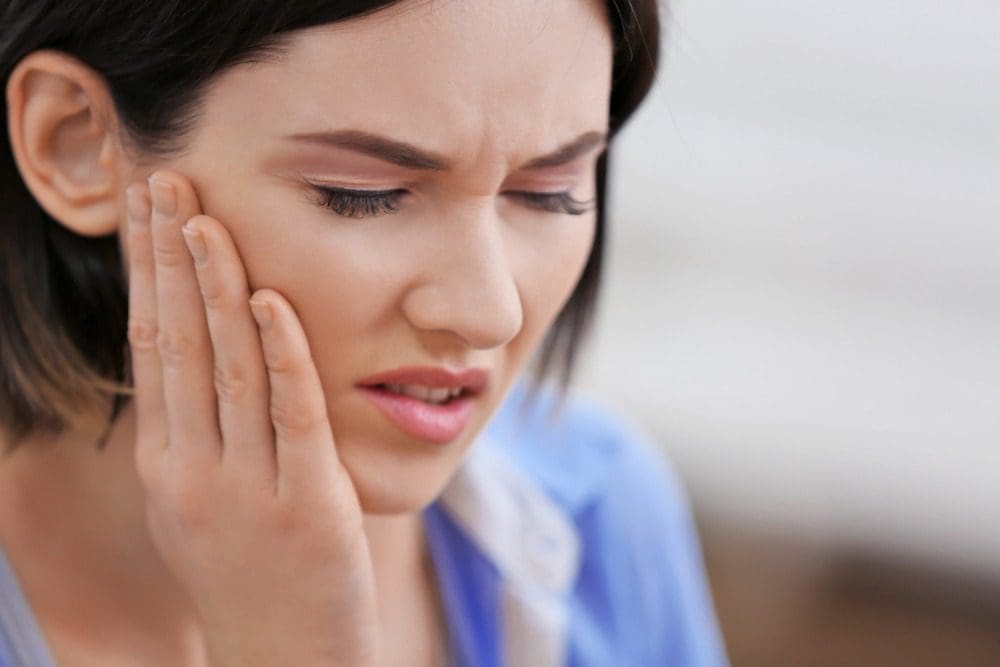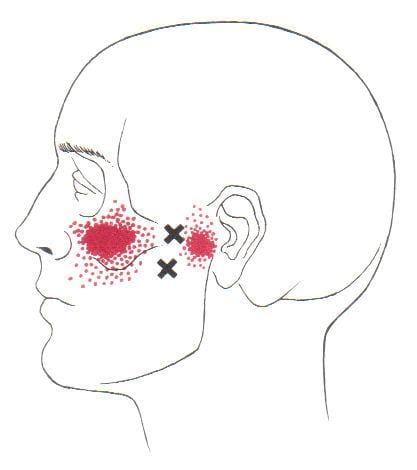Table of Contents
Introduction
The jaw allows the host to chew, speak, and move while being stabilized by the surrounding muscles that help the jaw structure. The other surrounding muscles that support the jaw are the neck muscles when food is consumed and swallowed. The lower jaw has joints on each side that connect to the upper part of the skull, while the surrounding muscles provide the motor function to the jaw. To that point, normal wear and tear or various factors can not only affect the joints and the surrounding muscles, but they can cause overlapping pain profiles to the tendons, organs, and jaw muscles that may potentially affect a person’s quality of life. Today’s article examines the lateral pterygoid muscle, how TMJ dysfunction and trigger points affect this muscle, and ways to manage TMJ dysfunction and trigger points in the jaw. We refer patients to certified providers who specialize in musculoskeletal treatments to aid individuals suffering from trigger point pain associated with TMJ dysfunction affecting the lateral pterygoid muscle. We also guide our patients by referring them to our associated medical providers based on their examination when appropriate. We ensure to find that education is the solution to asking our providers insightful questions. Dr. Jimenez DC observes this information as an educational service only. Disclaimer
What Is The Lateral Pterygoid Muscle
Have you heard popping sounds in your jaw when you open or close your mouth? Does your jaw feel stiff, and the pain travels down the neck? Does your jaw lock up, causing difficulty for you to open or close your mouth? Some of these symptom overlap with pain associated with the lateral pterygoid muscle. As part of the mastication muscles, the lateral pterygoid muscle is also a craniomandibular muscle that has a crucial role in the inferior temporal region. The lateral pterygoid muscle works together with the medial pterygoid muscle to provide functionality to the mandible or the lower jaw. The lateral pterygoid muscle also has nerves that branch off the trigeminal nerve and sends information to the brain. This information causes the muscles to move and function when food is consumed; however, when injuries or traumatic events affect the lateral pterygoid, it can disrupt the lower jaw structure and the surrounding muscles.
How TMJ Dysfunction & Trigger Points Affect The Lateral Pterygoid
When the lateral pterygoid is affected by TMJ (temporomandibular joint) dysfunction, studies reveal that many individuals often experience pain around the jaw causing limited jaw movement and pain in the lateral pterygoid muscles. When the lateral pterygoid muscles become overused due to excessive chewing or by traumatic forces that affect the jaw, it can cause the muscle fibers of the lateral pterygoid to develop tiny knots known as trigger points to affect the jawline. Trigger points cause pain symptoms associated with other chronic issues that cause jaw pain. When trigger points affect the lateral pterygoid, it can develop discomfort and pain in TMJ dysfunction.
According to Dr. Janet G. Travell, M.D., many people with severe pain in their jaws may have myofascial pain syndrome from musculoskeletal disorders caused by active trigger points in the lateral pterygoid muscle. Since the lateral pterygoid is potentially involved with trigger points associated with TMJ dysfunction, studies reveal that the lateral pterygoid muscle may suffer from muscle atrophy while correlating with disc displacement associated with TMJ dysfunction. TMJ dysfunction is when the surrounding muscles and ligaments around the lower jaw are irritated from active trigger points. When a person suffers from TMJ dysfunction, the pterygoid muscles become stiff and cause pain-related symptoms affecting the jaw and the surrounding oral-facial region.
Jaw Pain & TMJ Dysfunction-Video
Have you been experiencing pain along your jawline? Do your jaw muscles feel stiff when your open or close your mouth? Have you heard popping sounds when you open your jaw, and it hurts? Many of these symptoms are associated with TMJ dysfunction affecting the lateral pterygoid muscle. The video above explains how TMJ disorder and jaw pain affect the body. Studies reveal that the activities of the lateral pterygoid muscle allow movement to the jaw for the host; however, when factors begin to affect the jaw and the lateral pterygoid muscle, it may lead to derangement and disc displacement in the TMJ. TMJ dysfunction associated with trigger points in the jaw may be combined with other factors that cause pain to the jaw and the rest of the body. This is known as somato-visceral pain, where the muscle affects the corresponding organ. TMJ dysfunction associated with trigger points is complex and challenging to diagnose since trigger points often mimic other chronic symptoms that may be potentially involved. Since the lateral pterygoid muscle has sensory-motor functions in the jaw, when the muscle becomes sensitive, those neuron signals become hypersensitive and cause disorganized muscular activation to the jaw; thus, determining factors in TMD (temporomandibular disorders) make an appearance. Luckily there are ways to manage TMJ dysfunction associated with trigger pain in the jaw from affecting anyone.
Managing TMJ Dysfunction & Trigger Pain In The Jaw
When a person is experiencing pain symptoms in the jaw from TMJ dysfunction associated with trigger point pain, many try to find various treatments to minimize the pain. Since trigger point pain in the jaw can cause referred pain associated with toothaches and tension-type headaches, the pain that a person is feeling can be confusing when there is no physical alteration. To that point, many people would take over-the-counter medicine to dull the pain. However, those who want to manage pain without medication can go to a musculoskeletal specialist that their primary doctor refers to, who can come up with a treatment plan catered to that person. Many musculoskeletal specialists, like chiropractors, can obtain the patient’s information on where they feel pain during the examination. Afterward, chiropractors can devise a solution through clinical thinking before applying the treatment to the patient’s pain. Some of the various techniques that a chiropractor utilizes for an individual dealing with jaw pain associated with trigger points include:
- Stretch and spray: Where the lateral muscle is stretched and sprayed with a coolant to alleviate the trigger points.
- Cervical spinal manipulation: Spinal adjustment to the cervical spine to loosen up stiff muscles surrounding the neck and lower jaw.
- Heat compression: A hot pack is placed on the jaw to relax the muscles.
When chiropractors utilize these techniques on the trigger points affecting the lateral pterygoid, it may potentially alleviate TMJ dysfunction symptoms associated with trigger points.
Conclusion
The lateral pterygoid is part of the mastication muscles that work with the medial pterygoid muscle to stabilize the jaw and provide motor function when the host is chewing or speaking. When the lateral pterygoid muscle becomes overused through excessive chewing or being affected by traumatic factors can cause the development of pain symptoms associated with trigger points. Trigger points are tiny knots in the muscle that can cause referred pain to different locations in the body. When this happens, many individuals suffer from other chronic conditions associated with trigger points. One of them is TMJ dysfunction, where the surrounding muscles in the lower jaw become irritated and can make the jaw lock up. Fortunately, various treatments exist for many individuals to relieve trigger point pain associated with TMJ dysfunction affecting their jaws and help prevent the associated symptoms from progressing further.
References
Litko, Monika, et al. “Correlation between the Lateral Pterygoid Muscle Attachment Type and Temporomandibular Joint Disc Position in Magnetic Resonance Imaging.” Dento Maxillo Facial Radiology, The British Institute of Radiology., Oct. 2016, www.ncbi.nlm.nih.gov/pmc/articles/PMC5595028/.
Liu, Meng-Qi, et al. “Functional Changes of the Lateral Pterygoid Muscle in Patients with Temporomandibular Disorders: A Pilot Magnetic Resonance Images Texture Study.” Chinese Medical Journal, Wolters Kluwer Health, 5 Mar. 2020, www.ncbi.nlm.nih.gov/pmc/articles/PMC7065862/.
Lopes, Sérgio Lúcio Pereira de Castro, et al. “Lateral Pterygoid Muscle Volume and Migraine in Patients with Temporomandibular Disorders.” Imaging Science in Dentistry, Korean Academy of Oral and Maxillofacial Radiology, Mar. 2015, www.ncbi.nlm.nih.gov/pmc/articles/PMC4362986/.
Rathee, Manu, and Prachi Jain. “Anatomy, Head and Neck, Lateral Pterygoid Muscle.” In: StatPearls [Internet]. Treasure Island (FL), StatPearls Publishing, 29 Oct. 2021, www.ncbi.nlm.nih.gov/books/NBK549799/.
Disclaimer
Post Disclaimer
Professional Scope of Practice *
The information herein on "TMJ Dysfunction On The Lateral Pterygoid Muscle" is not intended to replace a one-on-one relationship with a qualified health care professional or licensed physician and is not medical advice. We encourage you to make healthcare decisions based on your research and partnership with a qualified healthcare professional.
Blog Information & Scope Discussions
Our information scope is limited to Chiropractic, musculoskeletal, physical medicines, wellness, contributing etiological viscerosomatic disturbances within clinical presentations, associated somatovisceral reflex clinical dynamics, subluxation complexes, sensitive health issues, and/or functional medicine articles, topics, and discussions.
We provide and present clinical collaboration with specialists from various disciplines. Each specialist is governed by their professional scope of practice and their jurisdiction of licensure. We use functional health & wellness protocols to treat and support care for the injuries or disorders of the musculoskeletal system.
Our videos, posts, topics, subjects, and insights cover clinical matters, issues, and topics that relate to and directly or indirectly support our clinical scope of practice.*
Our office has reasonably attempted to provide supportive citations and has identified the relevant research study or studies supporting our posts. We provide copies of supporting research studies available to regulatory boards and the public upon request.
We understand that we cover matters that require an additional explanation of how it may assist in a particular care plan or treatment protocol; therefore, to further discuss the subject matter above, please feel free to ask Dr. Alex Jimenez, DC, or contact us at 915-850-0900.
We are here to help you and your family.
Blessings
Dr. Alex Jimenez DC, MSACP, RN*, CCST, IFMCP*, CIFM*, ATN*
email: coach@elpasofunctionalmedicine.com
Licensed as a Doctor of Chiropractic (DC) in Texas & New Mexico*
Texas DC License # TX5807, New Mexico DC License # NM-DC2182
Licensed as a Registered Nurse (RN*) in Florida
Florida License RN License # RN9617241 (Control No. 3558029)
License Compact Status: Multi-State License: Authorized to Practice in 40 States*
Presently Matriculated: ICHS: MSN* FNP (Family Nurse Practitioner Program)
Dr. Alex Jimenez DC, MSACP, RN* CIFM*, IFMCP*, ATN*, CCST
My Digital Business Card





